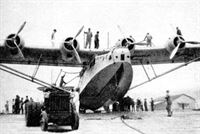Фотографии
-
A poor-quality but extremely rare image scanned from the pages of the March 1943 issue of Japanese monthly magazine Koku Asahi showing a Kawanishi Type 97 under construction at Naruo.
Самолёты на фотографии: Kawanishi H6K - Япония - 1936
-
An H6K2 of Dai Nippon Koku taxies with its two outboard engines running. The men on the port wing are probably the two mechanics taken on every flight as part of the crew. The H6K2-L’s Mitsubishi Kinsei engines were extremely reliable and it was one of the best aero-engines to be produced by the Japanese during the period.
Самолёты на фотографии: Kawanishi H6K - Япония - 1936
-
Регистрационный номер: J-BFOZ One of the early H6K2-Ls, J-BFOZ Ayanami, is inspected by officials before a flight to the South Seas. In Dai Nippon Koku service the flying-boats incorporated the Hinomaru (sun) symbol on the fuselage aft of the parasol wing, with the registration aft of that and the letter J (for Japan) on the inner and outer sides of the rudders.
Самолёты на фотографии: Kawanishi H6K - Япония - 1936
-
Another image from the August 1941 issue of Koku Asahi showing a Dai Nippon Koku H6K2 being prepared for a flight on the Japan-Saipan-Palau service at the airline’s base at Yokohama in Tokyo Bay. After Japan’s entry into the Second World War in late 1941, the military Type 97s were given the Allied codename Mavis.
Самолёты на фотографии: Kawanishi H6K - Япония - 1936
-
LEFT Dai Nippon Koku aircrew certainly earned their pay; a pilot and copilot would fly the entire flight from Japan to Saipan, rest for a day or two, then fly on to Palau before making the return flight. RIGHT Every flight to the South Seas carried two radiomen who were in constant touch with the airline’s stations along the route.
Самолёты на фотографии: Kawanishi H6K - Япония - 1936
-
LEFT Dai Nippon Koku’s H6K2-Ls were equipped with two passenger compartments, the forward compartment seating seven passengers in large comfortable seats, as this image from the August 1941 issue of Koku Asahi shows.
RIGHT For night flights the forward cabin was reconfigured to accommodate four beds.Самолёты на фотографии: Kawanishi H6K - Япония - 1936
-
The rear compartment of the H6K2-L had ten seats for passengers, with tray tables set into the rear of each.
Самолёты на фотографии: Kawanishi H6K - Япония - 1936
-
Самолёты на фотографии: Kawanishi H6K - Япония - 1936
-
Two Douglas DF flying-boats were acquired by Japan Air Transport in 1936 and given the civil registrations J-ANET and J-ANFS. The former was dismantled for evaluation by Kawanishi and J-ANET was lost during a flight from Tokyo to Saipan in 1938.
Самолёты на фотографии: Douglas DF - США - 1936
Статьи
- -
- C.Gibson - Pirates of the South Atlantics
- E.Young - To the south seas and beyond
- I.Thirsk, M.Packham - Would the real HR204 please stand up?
- J.Kightly, R.Reis - The power of three
- K.Hayward - The De Havilland Comet & the British Government. The knife's edge (2)
- L.Hellstrom - Waiting in the wings
- M.Willis - The missing link?
- P.Davidson - Off the Beaten Track...
- P.Jarrett - Lost & Found
- P.Marson - Southern charm
- R.Braybrook - "If only..." A British Cold War Aircraft Designer in West Germany, 1962
- R.Forsyth, A.Dillmann - Eyes of the Luftwaffe (1)
- R.Lezon - From West London to South America
- V.Flintham - Dirty work (1)








